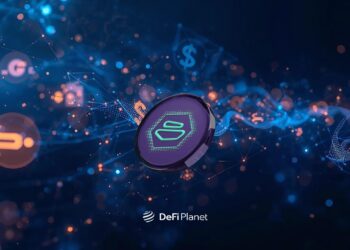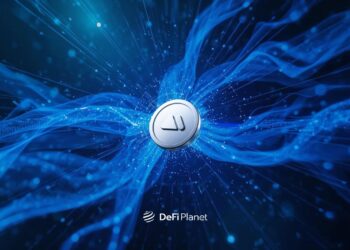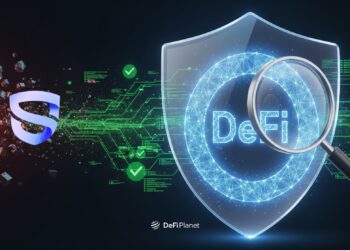DeFi is evolving rapidly, and with it comes a rising demand for high-performance infrastructure, especially when it comes to real-time trading. From derivatives and perpetuals to decentralized exchanges (DEXs), users now expect low latency, high throughput, and fast order execution to compete with centralized platforms.
However, most Layer 1 blockchains, like Ethereum and Avalanche, often fall short in this area. They weren’t built specifically for trading. As a result, network congestion, unpredictable gas fees, and slower transaction finality continue to be major obstacles for DeFi protocols aiming to offer a smooth, exchange-like experience.
That’s why Sei Network was created. Developed by Jeffrey Feng and Jayendra Jog of Sei Lab, Sei is a blockchain built specifically for trading. It promises lightning-fast finality, in-built order matching, and uses a design made for high-speed trading. But is the Sei Network ready to lead the DeFi race?
What is Sei Network and How Does it Work?
Sei Network is a high-speed Layer 1 blockchain built to run dApps quickly and efficiently. It combines the fast performance of Solana and the developer-friendly tools of Ethereum, making it a great platform for building blockchain-based applications.
A unique feature of Sei is its built-in order-matching engine, which helps make trades smoother and prevents front-running (when someone jumps ahead of your trade unfairly). Sei is built using Cosmos SDK and Tendermint Core, meaning it can easily connect and share information with other blockchains using the IBC (Inter-Blockchain Communication) protocol.
How Does Sei Network Work?
Twin Turbo Consensus
Sei Network’s Twin Turbo Consensus is built for speed. It’s not a brand-new consensus model but rather an optimized version of the Tendermint BFT (Byzantine Fault Tolerant) engine, fine-tuned to deliver block finality in about 400 milliseconds.
The secret? Aggressive performance tuning and tight integration with Sei’s parallel execution system and storage layer (SeiDB). By streamlining how transactions are proposed, verified, and finalized, Sei pipelines the usual Tendermint steps, propose, prevote, precommit, commit, to run more efficiently.
This makes Sei Network ideal for fast-paced, decentralized apps, especially those that need instant transaction confirmation, like finance, gaming, or on-chain trading platforms. Twin Turbo Consensus helps the Layer-1 blockchain support the next generation of high-performance Web3 applications by making block confirmations nearly instant.
Sei Parallelization Engine
Sei is designed to handle high-speed transactions and scale efficiently. Its standout feature is the Sei Parallelization Engine, which allows multiple transactions to be processed at the same time, also known as parallel execution. This breaks away from the slower, traditional method of processing one transaction after another (sequential execution).
To make this work, Sei Network uses Optimistic Concurrency Control (OCC). Instead of locking data before a transaction runs (which slows things down), OCC lets transactions run in parallel based on an estimate of the data they’ll need.
If two transactions try to change the same data, the system catches the conflict and resolves it, usually by re-running the affected transactions.
This setup works best when most transactions don’t interfere with each other, allowing the network to use multi-core processors efficiently and boost performance without unnecessary delays.
SeiDB
SeiDB is a custom-built database system designed to handle blockchain storage more efficiently, especially for apps using the Ethereum Virtual Machine (EVM). It solves a common problem: traditional blockchain storage focuses more on cryptographic proof than on speed, which slows things down.
SeiDB changes that by using a hybrid design that keeps cryptographic security but speeds up how data is read and written.
Key Benefits of SeiDB:
- Faster access to blockchain data, even during busy times.
- Higher throughput for reads and writes, great for dApps with heavy traffic.
- Supports parallel execution, so multiple transactions can run at the same time without conflict.
- Stable performance, even when workloads spike or change.
SeiDB helps make the Layer-1 blockchain one of the fastest platforms for building and scaling decentralized applications.
DeFi Ecosystem on Sei: Projects and Protocols
Sei’s fast, scalable architecture is powering a growing DeFi ecosystem. It’s an optimized trading infrastructure for lending, staking, and cross-chain activity.
Decentralized Exchanges (DEXs):
Sei Network’s infrastructure is designed for trading efficiency, with native support for high-speed order matching. This makes it ideal for DEXs that require low-latency and high-throughput environments. DEXs on Sei can support features like limit orders, market orders, and AMM models, benefiting from faster execution and fairer price discovery.
Lending Platforms:
With Sei’s sub-second finality and parallel execution, lending and borrowing platforms can deliver a smoother user experience with reduced wait times and transaction fees. These platforms allow users to supply and borrow assets while maintaining real-time responsiveness, crucial for managing collateral positions or liquidations.
Liquid Staking:
Protocols like Silo Stake enable users to stake SEI tokens while retaining liquidity through derivative tokens. This approach enhances network security while enabling stakers to engage in other DeFi activities, such as lending or yield farming, simultaneously using their staked assets.
Cross-Chain Applications:
Built on the Cosmos SDK and supporting the Inter-Blockchain Communication (IBC) protocol, Sei Network facilitates seamless interoperability with other blockchains in the Cosmos ecosystem. This enables users to transfer assets and interact with dApps across multiple networks, paving the way for truly cross-chain DeFi platforms.
NFT Marketplaces:
Sei’s speed and low transaction fees are well-suited for NFT trading. NFT platforms on Sei can offer near-instant minting and trading experiences, helping reduce congestion and costs typically seen on other chains. This makes it easier for creators and collectors to engage with NFTs in real time.
Other Projects:
The Sei ecosystem is expanding with infrastructure tools and cross-chain services. Relay enables fast, secure cross-chain payments. Leap Wallet offers a streamlined experience for managing SEI and interacting with dApps. Brahma focuses on efficient liquidity management across multiple chains, helping users move capital more intelligently in a multichain world.
Key Benefits of SEI Network’s Model
Sei Network was designed from the ground up to solve many of the performance and usability limitations seen in traditional blockchains and offer the following benefits:
Ultra-Fast Finality
Sei’s custom-built “Twin Turbo” consensus mechanism achieves high speed, creating an ideal environment for time-sensitive applications like DEXs, prediction markets, and gaming platforms where real-time interactions are critical. Unlike other chains where transactions can hang in limbo, Sei offers near-instant confirmations that boost both user experience and reliability.
Built-In Order-Matching Engine
Sei Network isn’t just fast, it’s optimized for trading. The network includes a native order-matching engine at the protocol level, giving DeFi builders a major head start when building DEXs and trading infrastructure platforms. This architecture helps prevent front-running and offers consistent, fair trade execution, a big improvement over traditional AMM models on slower blockchains.
Dual Smart Contract Environments
Sei supports both Ethereum-compatible smart contracts (via EVM) and CosmWasm contracts (written in Rust). This flexibility allows developers from different ecosystems to deploy on Sei without needing to learn a new programming language. Whether migrating an existing dApp or building from scratch, Sei offers a smooth developer experience.
Low Fees, High Throughput
Thanks to Sei’s efficient parallel execution and database design, users benefit from low-cost transactions, even during peak usage times. This makes Sei a practical option for applications with frequent microtransactions, such as GameFi platforms, NFT marketplaces, and global remittance tools.
Threats to Sei Network’s Success
The Sei Network also faces several challenges that could impact its growth, adoption, and long-term viability in the Web3 industry:
Fierce Competition from Other Layer-1s and L2s
Sei operates in a highly saturated market, competing directly with established Layer-1s like Ethereum, Solana, and Avalanche, as well as Layer-2 solutions like Arbitrum, Optimism, and Base. Many of these chains already have deeper liquidity, larger developer ecosystems, and institutional support. Without significant differentiation or ecosystem traction, Sei risks being overshadowed.
Ecosystem Maturity and Developer Adoption
Although Sei’s tech stack is promising, its ecosystem is still relatively young. Attracting and retaining developers long-term is critical, yet challenging, especially when competing platforms offer more grants, users, and tooling. If Sei can’t build a robust ecosystem of dApps, wallets, and infrastructure tools, it may struggle to gain meaningful network effects.
Regulatory Uncertainty
Sei’s native token (SEI) is used for governance, staking, and fees, but global regulators are increasingly scrutinizing token utility and classification. Any unfavourable rulings or enforcement actions, especially in major markets like the US or EU, could impact token trading, exchange listings, or user access to the network.
Low User Demand Without Killer dApps
No matter how fast or scalable Sei is, it needs compelling use cases to attract users. Without breakout apps, like a top-tier DEX, NFT marketplace, or GameFi platform, there may not be enough demand to justify using Sei over more established chains. A “build it and they will come” strategy doesn’t always work in crypto.
Conclusion: Can Sei Dominate the DeFi Layer-1 Race?
Sei Network still needs to check several boxes to truly break out:
- Expand DeFi dApp adoption beyond trading: success hinges on broadening its ecosystem with a broader range of protocols.
- Boost developer engagement by continuing to attract builders with strong tools, grants, and documentation.
- Integrate with wallets and aggregators, ensuring users can seamlessly access Sei-based apps.
- Maintain interoperability with other Cosmos chains and EVM networks to benefit from ecosystem composability.
Sei Network boasts a robust, trade-focused architecture, but it won’t dominate just on paper. Its success depends on sustained ecosystem growth, real-world performance, and practical education of both users and developers.
That said, Sei isn’t trying to be just another Layer‑1. It’s positioning itself as a purpose-built, DeFi-first chain that reimagines how fast, scalable trading infrastructure should work on-chain. Whether it can maintain momentum and deliver on that promise will determine if it can truly lead the next wave of decentralized finance.
Disclaimer: This article is intended solely for informational purposes and should not be considered trading or investment advice. Nothing herein should be construed as financial, legal, or tax advice. Trading or investing in cryptocurrencies carries a considerable risk of financial loss. Always conduct due diligence.
If you would like to read more articles like this, visit DeFi Planet and follow us on Twitter, LinkedIn, Facebook, Instagram, and CoinMarketCap Community.
Take control of your crypto portfolio with MARKETS PRO, DeFi Planet’s suite of analytics tools.”





















